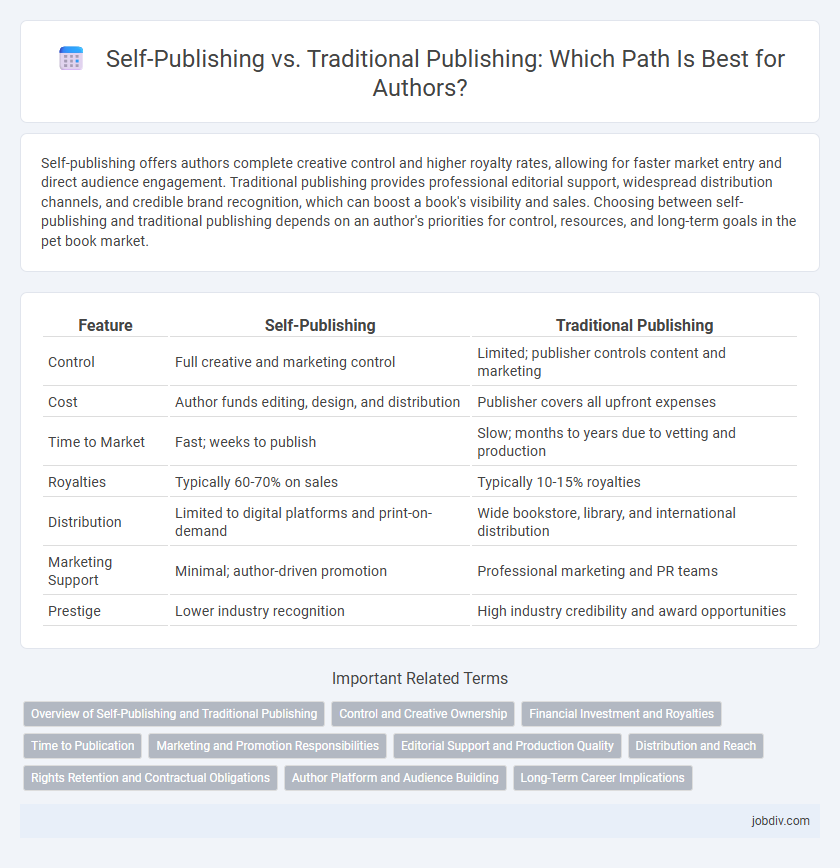Self-publishing offers authors complete creative control and higher royalty rates, allowing for faster market entry and direct audience engagement. Traditional publishing provides professional editorial support, widespread distribution channels, and credible brand recognition, which can boost a book's visibility and sales. Choosing between self-publishing and traditional publishing depends on an author's priorities for control, resources, and long-term goals in the pet book market.
Table of Comparison
| Feature | Self-Publishing | Traditional Publishing |
|---|---|---|
| Control | Full creative and marketing control | Limited; publisher controls content and marketing |
| Cost | Author funds editing, design, and distribution | Publisher covers all upfront expenses |
| Time to Market | Fast; weeks to publish | Slow; months to years due to vetting and production |
| Royalties | Typically 60-70% on sales | Typically 10-15% royalties |
| Distribution | Limited to digital platforms and print-on-demand | Wide bookstore, library, and international distribution |
| Marketing Support | Minimal; author-driven promotion | Professional marketing and PR teams |
| Prestige | Lower industry recognition | High industry credibility and award opportunities |
Overview of Self-Publishing and Traditional Publishing
Self-publishing enables authors to independently publish books, offering full creative control and higher royalty rates, often utilizing platforms like Amazon Kindle Direct Publishing. Traditional publishing involves established publishers managing editing, marketing, distribution, and financing, typically resulting in wider reach but lower royalty percentages for authors. The choice between self-publishing and traditional publishing hinges on factors such as creative control, upfront investment, marketing support, and speed to market.
Control and Creative Ownership
Self-publishing grants authors complete control over content, design, and marketing strategies, ensuring full creative ownership and quicker decision-making processes. In contrast, traditional publishing often involves relinquishing significant creative rights to editors and publishers, who influence cover design, editorial content, and distribution channels. Authors seeking artistic freedom and direct engagement with their audience may benefit more from self-publishing, while those preferring established industry support typically lean toward traditional publishing.
Financial Investment and Royalties
Self-publishing demands a higher upfront financial investment for editing, cover design, and marketing but offers authors full control over pricing and royalties, often ranging from 35% to 70%. Traditional publishing requires minimal initial costs from authors, yet royalty rates are typically lower, averaging between 10% and 15%, with publishers covering production expenses. Financial returns in self-publishing can be more substantial if marketing is effective, while traditional publishing provides wider distribution channels and advance payments.
Time to Publication
Self-publishing offers significantly faster time to publication, often allowing authors to release their work within weeks. Traditional publishing typically involves a lengthy process, taking anywhere from 12 to 24 months due to manuscript review, editing, and marketing preparations. Authors prioritizing speed often choose self-publishing to bypass the extended timelines characteristic of traditional routes.
Marketing and Promotion Responsibilities
In self-publishing, authors bear the full responsibility for marketing and promotion, using social media, book tours, and paid advertising to reach their audience. Traditional publishing companies provide professional marketing teams and established distribution channels, significantly increasing a book's visibility and sales potential. Effective promotion strategies in traditional publishing often include bookstore placements, media coverage, and targeted campaigns coordinated by publicists.
Editorial Support and Production Quality
Traditional publishing offers extensive editorial support, including professional editing, proofreading, and design teams that enhance the final manuscript and ensure high production quality. Self-publishing grants authors complete control but often requires outsourcing editorial and design services, which can vary significantly in quality and consistency. The structured processes in traditional publishing typically result in polished, market-ready books, while self-publishing demands greater investment in professional resources to achieve comparable production standards.
Distribution and Reach
Self-publishing offers authors direct control over distribution, utilizing platforms like Amazon Kindle Direct Publishing and Smashwords to reach a global audience quickly. Traditional publishing leverages established distribution networks, including bookstores, libraries, and international distributors, ensuring broader physical presence and market penetration. While self-publishing enables faster market entry, traditional publishing typically provides greater access to mainstream retail channels and professional marketing support.
Rights Retention and Contractual Obligations
Self-publishing offers authors full rights retention, allowing complete control over their work without restrictive contractual obligations typically imposed by traditional publishing houses. In traditional publishing, authors often sign contracts that transfer significant rights to the publisher, limiting control over distribution, adaptations, and royalties. Retaining rights through self-publishing enables greater flexibility in marketing, pricing, and intellectual property decisions, enhancing potential long-term earnings and creative freedom.
Author Platform and Audience Building
Developing a strong author platform is crucial for self-publishing success, enabling writers to directly connect with their target audience through social media, blogs, and email newsletters. Traditional publishing often relies on established marketing channels but may offer limited author control over audience engagement strategies. Effective audience building in self-publishing results in sustained book sales and long-term reader relationships, critical components for emerging authors seeking market visibility.
Long-Term Career Implications
Self-publishing offers authors complete control over their work and higher royalty rates, supporting entrepreneurial growth and faster market entry crucial for building a sustainable author brand. Traditional publishing provides access to established distribution networks, professional editing, and marketing resources, enhancing credibility and long-term visibility in the literary market. While self-publishing fosters agility and direct audience engagement, traditional publishing often secures enduring institutional support, which can significantly impact an author's career longevity and reputation.
Self-Publishing vs Traditional Publishing Infographic

 jobdiv.com
jobdiv.com